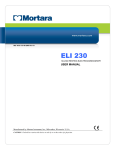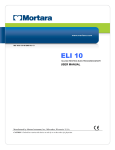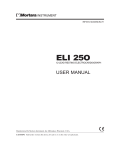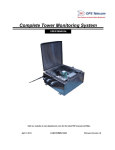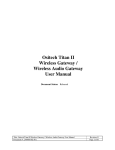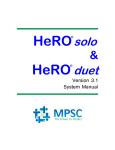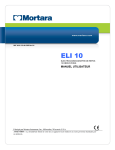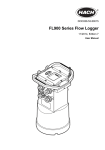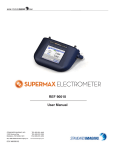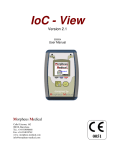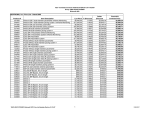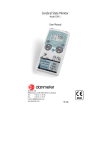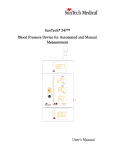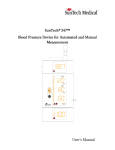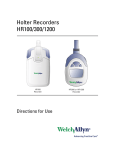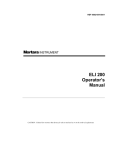Download ReadyLink Operating Instructions ( PDF )
Transcript
Operating Instructions Manufactured by Mortara Instrument, Inc., Milwaukee, Wisconsin U.S.A. CAUTION: Federal law restricts this device to sale by or on the order of a physician. REF 9515-170-70-ENG Rev C1 © 2011 Mortara Instrument, Inc. All rights reserved. This document contains confidential information that belongs to Mortara Instrument, Inc. and Physio Control Inc. No part of this document may be transmitted, reproduced, used, or disclosed outside of the receiving organization without the express written consent of Mortara Instrument, Inc. Physio Control Inc. ReadyLink, ELI, and VERITAS are registered trademarks. Cisco® is the registered trademark of Cisco Systems, Inc. DICOM® is the registered trademark of the National Electrical Manufacturers Association for its standards publications relating to digital communications of medical information. V1.13 TECHNICAL SUPPORT AND SERVICE Headquarters Technical Support Physio-Control, Inc. 11811 Willows Road NE Redmond, WA 98052 www.physio-control.com Physio-Control, Inc 11811 Willows Road NE Redmond, WA 98052 Tel: Fax: 800 442 1142 800 426 8049 Tel: 800 732 3081 Email: [email protected] i NOTICES Manufacturer Mortara Instrument, Inc. 7865 N. 86th Street Milwaukee, Wisconsin 53224 European Union Representative Mortara Rangoni Europe, Srl Via Cimarosa 103/105 40033 Casalecchio di Reno (BO) Italy Tel: +39.051.298.7811 Fax: +39.051.613.3582 Manufacturer’s Responsibility Mortara Instrument, Inc. is responsible for the effects on safety and performance only if: • Assembly operations, extensions, readjustments, modifications, or repairs are carried out only by persons authorized by Mortara Instrument, Inc. • The device is used in accordance with the instructions for use. Responsibility of the Customer The user of this device is responsible for ensuring the implementation of a satisfactory maintenance schedule. Failure to do so may cause undue failure and possible health hazards. Equipment Identification Mortara Instrument, Inc. equipment is identified by a serial and reference number on the back of the device. Care should be taken so that these numbers are not defaced. Copyright and Trademark Notices This document contains information that is protected by copyright. All rights are reserved. No part of this document may be photocopied, reproduced, or translated to another language without prior written consent of Mortara Instrument, Inc. Other Important Information The information in this document is subject to change without notice. Mortara Instrument, Inc. makes no warranty of any kind with regard to this material including, but not limited to, implied warranties of merchantability and fitness for a particular purpose. Mortara Instrument, Inc. assumes no responsibility for any errors or omissions that may appear in this document. Mortara Instrument, Inc. makes no commitment to update or to keep current the information contained in this document. ii WARRANTY INFORMATION Your Warranty MORTARA INSTRUMENT, INC. (hereinafter referred to as “Mortara”) hereby warrants that Mortara products (hereinafter referred to as “Product/s”) shall be free from defects in material and workmanship under normal use, service, and maintenance for the warranty period of such Product/s from Mortara or an authorized distributor or representative of Mortara. The warranty period is defined as twelve (12) months following the date of shipment to the end-user by Physio Control. Normal use, service, and maintenance means operation and maintenance in accordance with appropriate instructions and/or information guides. This warranty does not apply to damage to the Product/s caused by any or all of the following circumstances or conditions: a) Freight damage; b) Parts and/or accessories of the Product/s not obtained from or approved by Mortara; c) Misapplication, misuse, abuse, and/or failure to follow the Product/s instruction sheets and/or information guides; d) Accident; a disaster affecting the Product/s; e) Alterations and/or modifications to the Product/s not authorized by Mortara; f) Other events outside of Mortara’s reasonable control or not arising under normal operating conditions. THE REMEDY UNDER THIS WARRANTY IS LIMITED TO THE REPAIR OR REPLACEMENT WITHOUT CHARGE FOR LABOR OR MATERIALS, OR ANY PRODUCT/S FOUND UPON EXAMINATION BY MORTARA TO HAVE BEEN DEFECTIVE. This remedy shall be conditioned upon receipt of notice by Mortara of any alleged defects promptly after discovery thereof within the warranty period. Mortara’s obligations under the foregoing warranty will further be conditioned upon the assumption by the purchaser of the Product/s (i) of all carrier charges with respect to any Product/s returned to Mortara’s principal place or any other place as specifically designated by Mortara or an authorized distributor or representative of Mortara, and (ii) all risk of loss in transit. It is expressly agreed that the liability of Mortara is limited and that Mortara does not function as an insurer. A purchaser of a Product/s, by its acceptance and purchase thereof, acknowledges and agrees that Mortara is not liable for loss, harm, or damage due directly or indirectly to an occurrence or consequence therefrom relating to the Product/s. If Mortara should be found liable to anyone under any theory (except the expressed warranty set forth herein) for loss, harm, or damage, the liability of Mortara shall be limited to the lesser of the actual loss, harm, or damage, or the original purchase price of the Product/s when sold. EXCLUDED FROM THE LIMITED WARRANTY SET FORTH ABOVE ARE CONSUMABLE ITEMS SUCH AS PAPER, BATTERIES, ELECTRODES, PATIENT CABLES, LEAD WIRES, AND MAGNETIC STORAGE MEDIUMS. EXCEPT AS SET FORTH HEREIN WITH RESPECT TO REIMBURSEMENT OF LABOR CHARGES, A PURCHASER’S SOLE EXCLUSIVE REMEDY AGAINST MORTARA FOR CLAIMS RELATING TO THE PRODUCT/S FOR ANY AND ALL LOSSES AND DAMAGES RESULTING FROM ANY CAUSE SHALL BE THE REPAIR OR REPLACEMENT OF DEFECTIVE PRODUCT/S TO THE EXTENT THAT THE DEFECT IS NOTICED AND MORTARA IS NOTIFIED WITHIN THE WARRANTY PERIOD. IN NO EVENT, INCLUDING THE CLAIM FOR NEGLIGENCE, SHALL MORTARA BE LIABLE FOR INCIDENTAL, SPECIAL, OR CONSEQUENTIAL DAMAGES, OR FOR ANY OTHER LOSS, DAMAGE, OR EXPENSE OF ANY KIND, INCLUDING LOSS OF PROFITS, WHETHER UNDER TORT, NEGLIGENCE OR STRICT LIABILITY THEORIES OF LAW, OR OTHERWISE. THIS WARRANTY IS EXPRESSLY IN LIEU OF ANY OTHER WARRANTIES, EXPRESS OR IMPLIED, INCLUDING, BUT NOT LIMITED TO THE IMPLIED WARRANTY OF MERCHANTABILITY AND THE WARRANTY OF FITNESS FOR A PARTICULAR PURPOSE. iii WARRANTY INFORMATION iv USER SAFETY INFORMATION Warning: Means there is the possibility of personal injury to you or others. Caution: Means there is the possibility of damage to the device. Note: Provides information to further assist in the use of the device. Warning(s) • This manual gives important information about the use and safety of this device. Deviating from operating procedures, misuse or misapplication of the device, or ignoring specifications and recommendations could result in increased risk of harm to users, patients and bystanders, or damage to the device. • To maintain operator and patient safety when connected to an AC Mains power source, only the following AC/DC power converters should be attached to the cradle PWR (power) receptacle: • Ault, Inc., Model MW117, Type: xx0503Fxx (x = variations not affecting safety) • Globtek, Inc., Model GTM21089-1305-T3 • Device captures and presents data reflecting a patient’s physiological condition that when reviewed by a trained physician or clinician can be useful in determining a diagnosis; however, the data should not be used as a sole means for determining a patient’s diagnosis. • Users are expected to be licensed clinical professionals knowledgeable about medical procedures and patient care, and adequately trained in the use of this device. Before attempting to use this device for clinical applications, the operator must read and understand the contents of the user manual and other accompanying documents. Inadequate knowledge or training could result in increased risk of harm to users, patients and bystanders, or damage to the device. Contact Physio Control service for additional training options. • To ensure that electrical safety is maintained during operation from AC (~) power, the device must be plugged into a hospital-grade outlet. Where the integrity of external protective earth conductor arrangement is in doubt, the device shall be operated from its internal electrical power source. • To maintain designed operator and patient safety, peripheral equipment and accessories used that can come in direct patient contact must be in compliance with UL 60601-1, IEC 60601-1, and IEC 60601-2-25. Only use parts and accessories supplied with the device and available through Physio Control, Inc. • All signal input and output (I/O) connectors are intended for connection of only those devices complying with IEC 60601-1, or other IEC standards (e.g., IEC 60950), as appropriate to the device. Connecting additional devices to the device may increase chassis and/or patient leakage currents. To maintain operator and patient safety, consideration should be given to the requirements of IEC 60601-1-1, and leakage currents should be measured to confirm no electric shock hazard exists. • To maintain operator and patient safety, equipment connected to the same network as the device must meet the requirements of IEC 60950 or IEC 60601-1. • Patient cables intended for use with the device include series resistance (7 Kohm minimum) in each lead for defibrillation protection. Patient cables should be checked for cracks or breakage prior to use. v USER SAFETY INFORMATION • Conductive parts of the patient cable, electrodes, and associated connections of type CF applied parts, including the neutral conductor of the patient cable and electrodes, should not come into contact with other conductive parts including earth ground. • ECG electrodes could cause skin irritation; patients should be examined for signs of irritation or inflammation. • To avoid the possibility of serious injury or death during patient defibrillation, do not come into contact with device or patient cables. Additionally, proper placement of defibrillator paddles in relation to the electrodes is required to minimize harm to the patient. • This device was designed to use the electrodes specified in this manual. Proper clinical procedure must be employed to prep the electrode sites and to monitor the patient for excessive skin irritation, inflammation, or other adverse reactions. Electrodes are intended for short-term use and should be removed from the patient promptly following testing. • To avoid potential for spread of disease or infection, single-use disposable components (e.g., electrodes) must not be reused. To maintain safety and effectiveness, electrodes must not be used beyond their expiration date. • To ensure the safety of both the patient and the device, 1.5 meters (5’) of open area should surround the patient. No peripheral equipment may be connected to the device when within this patient area. • A possible explosion hazard exists. Do not use the device in the presence of a flammable anesthetic mixture. • There is a potential pinch hazard when inserting the device into its docking station and/or cradle that could result in minor injury. Care should be taken to avoid entrapment of fingers when performing this operation. • To improve immunity to potential interfering electromagnetic signals, shielded cabling is recommended when connecting the device to a network. • To prevent electric shock due to unequal ground potentials that may exist between points of a distributed network system or fault conditions in external network connected equipment, network cable shielding (where used) must be connected to protective earth ground appropriate to the area where the device is used. • The device has not been designed for use with high-frequency (HF) surgical equipment and does not provide a protective means against hazards to the patient. • The quality of the signal produced by the device may be adversely affected by the use of other medical equipment, including but not limited to defibrillators and ultrasound machines. • For proper operation and the safety of users or patients and bystanders, equipment and accessories must be connected only as described in this manual. Do not connect a telephone line cable to the LAN connector. • This device was designed for handheld or tabletop use. Only slight pressure is required to operate keys on the keyboard. To help avoid possible fatigue and related stress injuries, do not exert excessive force when pushing keys or continuously operate the device using the same finger and hand motions for long periods of time. vi USER SAFETY INFORMATION • Some Mortara electrocardiographs can be equipped with a GSM/GPRS (cellular modem) or wireless LAN (WLAN) module for transmitting ECG records. Device labeling and the presence of an antenna port will indicate if your device is equipped with such a module. If so equipped, the following notices apply: • The GSM/GPRS module operates in allocated frequency bands depending on the model. Identification of the installed GSM/GPRS module can be found on a label on the bottom of the device. • MultiTech Systems, Inc. Model MTSMC-G-F1 (Europe and elsewhere): 900/1800 MHz • MultiTech Systems, Inc. Model MTSMC-G-F2 (U.S. and elsewhere): 850/1900 MHz • MultiTech Systems, Inc. Model MTSMC-G-F4 (Quad Band): 900/1800 or 850/1900 MHz, user selectable • The WLAN identification can be found on a label on the bottom of the device. • Quatech, Inc. Model WLNG-AN-DP101: 2400 MHz • Use of the GSM/GPRS or WLAN module may interfere with other equipment operating in the vicinity. Check with local authorities or spectrum management officials in your facility to determine if restrictions apply to the use of this feature in your area. • Do not transmit via the GSM/GPRS or WLAN module with a missing or damaged antenna. Replace a damaged antenna immediately. • Use only the antenna supplied for use with this device. Unauthorized antennas, modifications, or attachments could damage the transmitter module and may contravene local RF emission regulations or invalidate type approval. • To ensure compliance with current regulations limiting both maximum RF output power and human exposure to radio frequency radiation, a separation distance of at least 20 cm must be maintained between the device's antenna and the head and body of the user and any nearby persons at all times. RF exposure to wrists and hands within the 20 cm distance while operating the device in the normal handheld position is not subject to the same distance restriction and is believed to be safe. To help prevent degradation of RF signal and to avoid excess RF energy absorption, do not touch the antenna during data transmission. • The GSM/GPRS and WLAN modules comply with applicable RF safety standards including standards and recommendations for the protection of public exposure to RF electromagnetic energy that have been established by governmental bodies and other qualified organizations, such as the following: • Federal Communications Commission (FCC) • Directives of the European Community • Directorate General V in Matters of Radio Frequency Electromagnetic Energy Caution(s) • To prevent possible damage to the keyboard, do not use sharp or hard objects to depress keys, only use fingertips. • Do not attempt to clean the device or patient cables by submersing into a liquid, autoclaving, or steam cleaning as this may damage equipment or reduce its usable life. Wipe the exterior surfaces with a warm water and mild detergent solution and then dry with a clean cloth. Use of unspecified cleaning/disinfecting agents, failure to follow recommended procedures, or contact with unspecified materials could result in increased risk of harm to users, patients and bystanders, or damage to the device. vii USER SAFETY INFORMATION • No user-serviceable parts inside. Screw removal by qualified service personnel only except for installation of SIM card. Damaged or suspected inoperative equipment must be immediately removed from use and must be checked/repaired by qualified service personnel prior to continued use. • The rechargeable internal battery is a sealed lithium ion type and it is totally maintenance free. If the battery appears to become defective, refer to Physio Control technical support. • Do not pull or stretch patient cables as this could result in mechanical and/or electrical failures. Patient cables should be stored after forming them into a loose loop. Note(s) • Patient movements may generate excessive noise that may affect the quality of the ECG traces and the proper analysis performed by the device. • Proper patient preparation is important to proper application of ECG electrodes and operation of the device. • There is no known safety hazard if other equipment, such as pacemakers or other stimulators, is used simultaneously with the device; however, disturbance to the signal may occur. • If an electrode is not connected properly to the patient, or one or more of the patient cable lead wires are damaged, the display will indicate a lead fault for the lead(s) where the condition is present. • Operation of the ReadyLink with an AC Mains power source connected to the PWR (power) receptacle on the cradle may produce unwanted noise in the ECG signal during acquisition. Disconnect the power source and operate from the internal battery when acquiring ECG data. • As defined by IEC 60601-1 and IEC 60601-2-25, the device is classified as follows: • Class I equipment (applies to entire product when the handheld unit is docked, and to the docking station and/or cradle alone) or internally powered (applies to handheld unit when not docked). • Type CF defibrillation-proof applied parts. • Ordinary equipment. • Equipment not suitable for use in the presence of a flammable anesthetic mixture. • Continuous operation. NOTE: From a safety perspective, per IEC 60601-1 and derivative standards/norms, this device is declared to be “Class I” and uses a three-prong inlet to ensure an earth connection is made along with mains. The ground terminal on the mains inlet on the docking station and/or cradle is the only protective earth point in the device. Exposed metal accessible during normal operation is double insulated from mains. Internal connections to earth ground are functional earth. • viii This device is primarily intended for use in hospitals but may be used in mobile environments (including prehospital, emergency medical services, ambulance and patient transport), medical clinics and offices of any size and should be used and stored according to the environmental conditions specified below: Operating temperature: Operating humidity: >0° to +40°C (>+32° to +104°F) 10% to 95% RH, non-condensing Storage temperature: Storage humidity: -20° to +60°C (-4° to +140°F) 5% to 95% RH, non-condensing Atmospheric pressure: 500 hPa to 1060 hPa USER SAFETY INFORMATION • The device will automatically turn off (blank screen) if the batteries have been severely discharged and the AC Mains is disconnected from the device. • After operating the device using battery power, always recharge the device. This ensures that the batteries will be automatically recharged for the next time you use the device. The display will indicate that the device is charging. • The device is UL classified: WITH RESPECT TO ELECTRIC SHOCK, FIRE AND MECHANICAL HAZARDS ONLY IN ACCORDANCE WITH UL2601-1, IEC60601-1, CAN/CSA CC22.2 No. 601.1, AND IEC60601-2-25 • When necessary, dispose of the device, its components and accessories (e.g., batteries, cables, electrodes), and/or packing materials in accordance with local regulations. Wireless Data Transmission • Some Mortara electrocardiographs can be equipped with an optional wireless data transmission module (WLAN or GSM/GPRS mobile). Both these technologies use radios to transmit data to a Mortara receiving application. Due to the nature of radio transmissions, it’s possible that, due to the characteristics of the environment where the device is located, some other RF sources may interfere with the transmission generated by the device. Mortara Instrument has tested the coexistence of the device with other devices that can interfere such as devices using WLAN, Bluetooth radio, and/or cell phones. Although the current technology allows a very successful rate of transmission, it’s possible that in some rare occurrences, the system may not perform at its best resulting in a “failed transmission”. When this occurs, patient data will not be erased from the device nor stored in the receiving application, ensuring that partial or corrupted data are not made available to the receiving station. If the failure mode persists the user should move to a position where the RF signals may propagate better and allow successful transmissions. WLAN Option • Wireless options transmit at 2.4 GHz. Other nearby wireless devices may cause interference. If possible, move or turn off other devices to minimize potential interference. • The following table shows the channels allocated in different geographic areas in the world. Please consult with your IT personnel in order to set the device on the proper channels. Specification Description Technology IEEE 802.11 b/g DSSS, WiFi compliant 2.400 – 2.4835 GHz (U.S./CAN/Japan/Europe) 2.471 – 2.497 GHz (Japan) U.S.A./CANADA: 11 channels (1-11) Europe: 13 Channels (1-13) Japan: 14 Channels (1-14) France: 4 Channels (10-13) +15dBm (typical) approx. 32 mW Frequency Channels RF Power ix USER SAFETY INFORMATION • The following table lists the frequency allocated for each channel used by the WLAN option. Channel Center Frequency Frequency Spread 1 2412 MHz 2399.5 MHz - 2424.5 MHz 2 2417 MHz 2404.5 MHz - 2429.5 MHz 3 2422 MHz 2409.5 MHz - 2434.5 MHz 4 2427 MHz 2414.5 MHz - 2439.5 MHz 5 2432 MHz 2419.5 MHz - 2444.5 MHz 6 2437 MHz 2424.5 MHz - 2449.5 MHz 7 2442 MHz 2429.5 MHz - 2454.5 MHz 8 2447 MHz 2434.5 MHz - 2459.5 MHz 9 2452 MHz 2439.5 MHz - 2464.5 MHz 10 2457 MHz 2444.5 MHz - 2469.5 MHz 11 2462 MHz 2449.5 MHz - 2474.5 MHz 12 2467 MHz 2454.5 MHz - 2479.5 MHz 13 2472 MHz 2459.5 MHz - 2484.5 MHz 14 2484 MHz 2471.5 MHz – 2496.5 MHz • In order to achieve the best transmission rate, it is necessary that the facility where the device is operated can provide good area coverage. Please consult the IT personnel of the facility to verify the proper WLAN availability in the area where the device will be used. • RF wave propagation may be blocked or reduced by the environment where the device is used. Most common areas where this may occur are: shielded rooms, elevators, underground rooms. In all such situations it is recommended to move the device to a proper location and verify with the IT personnel of the facility the areas where the WLAN signals are available. x EQUIPMENT SYMBOLS AND MARKINGS Symbol Delineation Attention, consult accompanying documents Alternating current Protective earth Fuse Telephone line (modem) Network (LAN) Defibrillator-proof type CF applied part ON/OFF (power) × Shift key (to enter upper case text) Space key Enter key (accept data/return) Universal Serial Bus (USB) xi EQUIPMENT SYMBOLS AND MARKINGS Do not dispose as unsorted municipal waste. Per EC Directive 2002/96, requires separate handling for waste disposal according to national requirements Antenna Indicates compliance to applicable EEC directives PWR xii Indicates power receptacle on the cradle accepts an AC/DC power converter. See Warnings for additional information. GENERAL CARE Precautions • • • Turn off the device before inspecting or cleaning. Do not immerse the device in water. Do not use organic solvents, ammonia-based solutions, or abrasive cleaning agents which may damage equipment surfaces. Inspection Inspect your equipment daily prior to operation. If you notice anything that requires repair, contact an authorized service person to make the repairs. • Verify that all cords and connectors are securely seated. • Check the case and chassis for any visible damage. • Inspect cords and connectors for any visible damage. • Inspect keys and controls for proper function and appearance. Cleaning Patient Cables 1. 2. 3. 4. 5. Remove cables and lead wires from device before cleaning. Clean the ECG patient cables with a damp sponge or cloth. Use only the cleaning agents listed below: • Quaternary ammonium compounds • Isopropyl alcohol • Peracetic (peroxide) acid solution Use caution with excess liquid as contact with metal parts may cause corrosion. Do not immerse cable ends or lead wires; immersion can cause metal corrosion. Do not use excessive drying techniques such as forced heat. WARNING: Do not attempt to clean/disinfect the device or patient cables by submerging into a liquid, autoclaving, or steam cleaning. Never expose cables to strong ultra-violet radiation. CAUTION – POSSIBLE EQUIPMENT DAMAGE: Do not clean the patient cables with bleach, bleach dilution, or phenolic compounds. Do not use abrasive or flammable cleaning agents Cleaning the Device Disconnect the power source. Clean the exterior surface of the device with a damp, soft, lint-free cloth using a solution of mild detergent diluted in water. After washing, thoroughly dry off the device with a clean, soft cloth or paper towel. Use caution with excess liquid as contact with metal parts may cause corrosion. Do not use excessive drying techniques such as forced heat. Sterilization Sterilization is not recommended for cables and lead wires. Cautions Improper cleaning products and processes can damage the device, produce brittle lead wires and cables, corrode the metal, and void the warranty. Use care and proper procedure whenever cleaning or maintaining the device. xiii GENERAL CARE xiv ELECTROMAGNETIC COMPATIBILITY (EMC) Electromagnetic compatibility with surrounding devices should be assessed when using the device. An electronic device can either generate or receive electromagnetic interference. Testing for electromagnetic compatibility (EMC) has been performed on the device according to the international standard for EMC for medical devices (IEC 60601-1-2). This IEC standard has been adopted in Europe as the European Norm (EN 60601-1-2). The device should not be used adjacent to, or stacked on top of other equipment. If the device must be used adjacent to or stacked on top of other equipment, verify that the device operates in an acceptable manner in the configuration in which it will be used. Fixed, portable, and mobile radio frequency communications equipment can affect the performance of medical equipment. See Table X-4 for recommended separation distances between the radio equipment and the device. The use of accessories, transducers, and cables other than those specified by Mortara Instrument may result in increased emissions or decreased immunity of the equipment. xv ELECTROMAGNETIC COMPATIBILITY (EMC) Table X-1 Guidance and Manufacturer’s Declaration: Electromagnetic Emissions The equipment is intended for use in the electromagnetic environment specified in the table below. The customer or the user of the equipment should ensure that it is used in such an environment. Emissions Test Compliance Electromagnetic Environment: Guidance RF Emissions CISPR 11 Group 1 The equipment uses RF energy only for its internal function. Therefore, its RF emissions are very low and not likely to cause any interference in nearby electronic equipment. RF Emissions CISPR 11 Class A Harmonic Emissions IEC 61000-3-2 Complies The equipment is suitable for use in all establishments other than domestic and those directly connected to the public lowvoltage power supply network that supplies buildings used for domestic purposes. Voltage Fluctuations/ Flicker Emissions IEC 61000-3-3 Complies Table X-2 Guidance and Manufacturer’s Declaration: Electromagnetic Immunity The equipment is intended for use in the electromagnetic environment specified in the table below. The customer or the user of the equipment should ensure that it is used in such an environment. Emissions Test Compliance Compliance Level Electromagnetic Environment: Guidance Electrostatic discharge (ESD) IEC 61000-4-2 +/- 6 kV contact +/- 8 kV air +/- 6 kV contact +/- 8 kV air Floors should be wood, concrete, or ceramic tile. If floors are covered with synthetic material, the relative humidity should be at least 30%. Electrical fast transient/burst IEC 61000-4-4 +/- 2 kV for power supply lines +/- 1 kV for input/output lines +/- 2 kV for power supply lines +/- 1 kV for input/output lines Mains power quality should be that of a typical commercial or hospital environment. Surge IEC 61000-4-5 +/- 1 kV differential mode +/- 2 kV common mode +/- 1 kV differential mode +/- 2 kV common mode Mains power quality should be that of a typical commercial or hospital environment. Voltage dips, short interruptions, and voltage variations on power supply input lines IEC 61000-4-11 <5% UT (>95% dip in UT) for 0.5 cycle 40% UT (60% dip in UT) for 5 cycles <5% UT (>95% dip in UT) for 0.5 cycle 40% UT (60% dip in UT) for 5 cycles Mains power quality should be that of a typical commercial or hospital environment. Power frequency (50/60 Hz) magnetic field 3 A/m 3 A/m Power frequency magnetic fields should be at levels characteristic of a typical location in a typical commercial or hospital environment. NOTE: UT is the AC Mains voltage prior to application of the test level. xvi ELECTROMAGNETIC COMPATIBILITY (EMC) Table X-3 Guidance and Manufacturer’s Declaration: Electromagnetic Immunity The equipment is intended for use in the electromagnetic environment specified in the table below. The customer or the user of the equipment should ensure that it is used in such an environment. Emissions Test IEC 60601 Test Level Compliance Level Electromagnetic Environment: Guidance Portable and mobile RF communications equipment should be used no closer to any part of the equipment, including cables, than the recommended separation distance calculated from the equation applicable to the frequency of the transmitter. Recommended separation distance Conducted RF IEC 61000-4-6 Radiated RF IEC 61000-4-3 3 Vrms 150 kHz to 80 MHz 3 V/m 80 MHz to 2.5 GHz 3 Vrms 150 kHz to 80 MHz 3 V/m 80 MHz to 2.5 GHz ⎡ 3.5 ⎤ d=⎢ ⎥ P ⎣ 3Vrms ⎦ ⎡ 3 .5 ⎤ 80 MHz to 800 MHz d=⎢ ⎥ P ⎣ 3V / m ⎦ ⎡ 7 ⎤ 800 MHz to 2.5 GHz d=⎢ ⎥ P ⎣ 3V / m ⎦ Where P is the maximum output power rating of the transmitter in watts (W) according to the transmitter manufacturer and d is the recommended separation distance in meters (m). Field strengths from fixed RF transmitters, as determined by an electromagnetic site surveya, should be less than the compliance level in each frequency rangeb. Interference may occur in the vicinity of equipment marked with the following symbol: a. Field strengths from fixed transmitters, such as base stations for radio (cellular/cordless) telephones and land mobile radios, amateur radios, AM and FM radio broadcast, and TV broadcast cannot be predicted theoretically with accuracy. To assess the electromagnetic environment due to fixed RF transmitters, an electromagnetic site survey should be considered. If the measured field strength in the location in which the equipment is used exceeds the applicable RF compliance level above, the equipment should be observed to verify normal operation. If abnormal performance is observed, additional measures may be necessary, such as reorienting or relocating the equipment. b. Over the frequency range 150 kHz to 80 MHz, field strengths should be less than [3] V/m. xvii ELECTROMAGNETIC COMPATIBILITY (EMC) Table X-4 Recommended Separation Distances Between Portable and Mobile RF Communications Equipment and the Equipment The equipment is intended for use in the electromagnetic environment in which radiated RF disturbances are controlled. The customer or the user of the equipment can help to prevent electromagnetic interference by maintaining a minimum distance between portable and mobile RF communications equipment (transmitters) and the equipment as recommended in the table below, according to the maximum output power of the communications equipment. Rated Maximum Output Power of Transmitter W Separation Distance According to Frequency of Transmitter (m) 150 KHz to 800 MHz 800 MHz to 2.5 GHz d = 1.2 P d = 2.3 P 0.01 0.1 m 0.2 m 0.1 0.4 m 0.7 m 1 1.2 m 2.3 m 10 4.0 m 7.0 m 100 12.0 m 23.0 m For transmitters rated at a maximum output power not listed above, the recommended separation distance d in meters (m) can be estimated using the equation applicable to the frequency of the transmitter, where P is the maximum output power rating of the transmitter in watts (W) according to the transmitter manufacturer. NOTE 1: At 800 MHz, the separation distance for the higher frequency range applies. NOTE 2: These guidelines may not apply in all situations. Electromagnetic propagation is affected by the absorption and reflection from structures, objects, and people. xviii TABLE OF CONTENTS INTRODUCTION SECTION 1 Manual Purpose ............................................................................................................................................................. 1 Audience ........................................................................................................................................................................ 1 Intended Use .................................................................................................................................................................. 1 Indications for Use ........................................................................................................................................................ 1 System Description ........................................................................................................................................................ 2 Figure 1-1, ReadyLink with Cradle and Carry Case ..................................................................................................... 3 Figure 1-2, Bottom of Cradle ........................................................................................................................................ 4 Figure 1-3, Display Overview (8-Lead Real-Time ECG View) .................................................................................... 5 Function Keys................................................................................................................................................................ 6 Feature Keys .................................................................................................................................................................. 7 Specifications ................................................................................................................................................................ 8 EQUIPMENT PREPARATION SECTION 2 Charging the ReadyLink................................................................................................................................................ 9 Using the Options Menu .............................................................................................................................................. 10 Setting Time and Date ................................................................................................................................................. 11 RECORD AN ECG SECTION 3 Patient Preparation....................................................................................................................................................... 13 Patient Hookup ............................................................................................................................................................ 13 Patient Hookup Summary Table ................................................................................................................... 14 Patient Demographic Entry ......................................................................................................................................... 15 ECG Acquisition/Viewing/Storage ............................................................................................................................. 15 Acquisition .................................................................................................................................................... 15 Viewing ......................................................................................................................................................... 16 Save (Storage) ............................................................................................................................................... 16 CONNECTIVITY AND ECG TRANSMISSION SECTION 4 ECG Transmission....................................................................................................................................................... 17 GSM/GPRS Mobile Transmission .............................................................................................................................. 18 ECG ARCHIVE SECTION 5 Archives....................................................................................................................................................................... 19 Sample Test Report ..................................................................................................................................................... 19 xix TABLE OF CONTENTS SYSTEM SETTINGS SECTION 6 Setting Technician Password ....................................................................................................................................... 21 Site Configuration ....................................................................................................................................................... 21 Accessing Configuration Menu ................................................................................................................................... 21 Abbreviated Configuration Settings .............................................................................................................. 22 TROUBLESHOOTING AND MAINTENANCE APPENDIX A ECG Record Errors...................................................................................................................................................... 23 Capturing ECG Errors ................................................................................................................................................. 23 Battery Errors .............................................................................................................................................................. 23 Password Errors ........................................................................................................................................................... 23 General Errors ............................................................................................................................................................. 23 Test Operation ............................................................................................................................................................. 24 Recommendations to Biomedical Staff ....................................................................................................................... 24 Battery Maintenance .................................................................................................................................................... 24 Calibration of the ReadyLink ...................................................................................................................................... 24 xx INTRODUCTION SECTION 1 Manual Purpose This manual is intended to provide the user with information about: • • • • • • • Using and understanding the ReadyLink 12-Lead ECG electrocardiograph, the function and feature keys, and the display screen. Preparing the ReadyLink for use. (Section 2) Acquiring, viewing, and storing an ECG. (Section 3) Connectivity and transmitting ECGs. (Section 4) Maintaining the ECG Archive. (Section 5) System settings. (Section 6) Maintenance and troubleshooting. (Appendix A) Audience This manual is written for clinical professionals. They are expected to have working knowledge of medical procedures and terminology as required for monitoring cardiac patients. Intended Use The ReadyLink 12-Lead ECG is intended to be a high-performance, multi-channel, multifunctional electrocardiograph. As a resting electrocardiograph, ReadyLink simultaneously acquires data from multiple channels. Once the data is acquired, it can be reviewed, stored, transmitted and/or printed. It will be a device primarily intended for use in hospitals, but may be used in mobile environments (including pre-hospital, emergency medical services, ambulance and patient transport), medical clinics and offices of any size. Indications for Use • • The device is indicated for use to acquire, analyze, display, transmit, print, record and store electrocardiograms. The device is indicated for use to provide interpretation of the data for consideration by a physician. • The device is indicated for use in a clinical setting, or mobile environments (including pre-hospital, emergency medical services, ambulance and patient transport), by a physician or by trained personnel who are acting on the orders of a licensed physician. It is not intended as a sole means of diagnosis. • The interpretations of ECG offered by the device are only significant when used in conjunction with a physician over-read as well as consideration of all other relevant patient data. • The device is indicated for use on adult and pediatric populations. • The device is not intended to be used as a vital signs physiological monitor. 1 SECTION 1 System Description The ReadyLink 12-Lead ECG is a 12-lead diagnostic electrocardiograph capable of acquiring, viewing, transmitting, and storing ECG data in mobile treatment environments. The ReadyLink is equipped with Mortara Instrument’s VERITAS™ resting ECG interpretation algorithm with age and gender specific criteria. The VERITAS algorithm can provide an over-reading physician with a silent second opinion through diagnostic statements output on the ECG report. Resting ECG Interpretation accuracies have not been validated under patient transport conditions. Noise generated during patient transport may impact the accuracy of interpretation. For additional information on the VERITAS algorithm, please refer to the Physician’s Guide to VERITAS with Adult and Pediatric Resting ECG Interpretation. The ReadyLink includes: • • • • • • • • • • • 2 ReadyLink 12-Lead ECG Patient cable Patient cable adaptor Cradle Antenna (with GSM/GPRS mobile and SIM card) Carry case Hospital grade power cord with charger Physician’s Guide to VERITAS with Adult and Pediatric Resting ECG Interpretation User’s manual Quick reference card Training video SECTION 1 ReadyLink with Cradle and Carry Case The ReadyLink ships pre-assembled within the carry case as shown below. In order to protect the device, do not remove it from the carry case. WARNING: Do not disconnect the patient cable from the device. Coil and store cable loosely. Inspect cable before each use and replace cable if bulges or other signs of damage are present. Figure 1-1 3 SECTION 1 Bottom of Cradle Figure 1-2 System Connectors A. LAN connector. B. USB connector for optional bar code scanner or removable data storage. C. DC power inlet. D. Green LED indicating power on. E. Flashing yellow LED indicating LAN connection. NOTE: The AC/DC converter and power cord serve as the AC Mains connection for the ReadyLink. To remove AC Mains, disconnect the power cord from the socket or AC/DC converter cable from the ReadyLink DC power inlet. NOTE: The AC/DC converter is meant for charging only. Remove the AC/DC converter when device is connected to a patient. WARNING: Only the specified AC/DC power converters should be used. See Warnings in the cover section. 4 SECTION 1 Display Overview (8-Lead Real-Time ECG View) Figure 1-3 NOTE: Device display defaults to real-time ECG view. The ReadyLink features a 320 x 240 pixel LCD display for valuable preview of ECG waveform, function-key labels, and other parameters as explained below: Heart rate (HR): When a patient is connected to the electrocardiograph, his/her HR is displayed in real time. The HR is the average ventricular rate measured over the 10-second rhythm on a standard ECG. HR is displayed in the upper left corner of the display screen. NOTE: If a lead fault occurs, the lead name flashes in this location until fault is corrected. In the event all leads are disconnected, “LEADS OFF” will flash until the fault is corrected. Speed: Speed in millimeters per second is displayed in the top center portion of the display screen to the right of HR. The default speed for rhythm viewing is 25 mm/s. Gain: Gain is displayed in the top center portion of the display screen to the right of speed. The waveform amplitude for display is 5 or 10 mm/mV depending on the displayed leads. 5 SECTION 1 Filter: Filter is displayed in the top center portion of the display screen to the right of Gain. The default filter setting is 150 Hz. Battery: Battery charge availability displays in increments of 25% in the bottom right-hand corner. When charging in its docking station or in its cradle and connected to the battery charger, the device’s battery gauge will be replaced with a flashing charging symbol indicating the device is charging. Once fully charged, the battery gauge displays at 100%. Clock: Time display with hour, minutes, and seconds resolution. (See Section 2 for setting a new time.) DOCKED/AC: “DOCKED/AC” is continuously displayed when the ReadyLink is properly docked in the cradle and is connected to the battery charger. This message disappears once the ReadyLink is removed from the cradle. If the device is not properly docked, “Attention: ReadyLink not properly docked.” is displayed until the error is corrected. DOCKED: “DOCKED” is continuously displayed when the unit is docked but no AC is connected (applies only when device is used with the cradle in the carrying case). Function Keys Function keys activate the LCD label adjacent to each function key. LCD labels/functions change depending upon the screen displayed. If the label is blank, the adjacent function key is not active. The following descriptions apply to those function keys available in the real-time ECG view. P-ID: Use P-ID to enter patient ID and demographic information. Leads: Use Leads to toggle between the eight initial default leads, a 3-lead view and between leads I, II, and III; aVR, aVL, and aVF; V1, V2 and V3; or V4, V5, and V6, or to display all 12-leads at one time. LCD S: Use LCDS to increase display contrast. LCDT: Use LCDT to decrease display contrast. 6 SECTION 1 Test: Use Test to initiate the transmission test function. The transmission test automatically initiates a GPRS connection to the cardiology management system, synchronizes the time, transfers a test file, and reports whether the transmission completed successfully. This transmission test is intended to be used regularly to verify the continued successful operation of the unit. Opt: Use Opt to enter the Options menu to access the Archives, Clock settings, Site settings, and configuration settings. Feature Keys Feature keys are used as a one-touch operation for: ECG ACQUISITION START/INITIATE TRANSMISSION CANCEL TRANSMISSION 7 SECTION 1 Specifications FEATURE SPECIFICATIONS Instrument Type 12-lead electrocardiograph Input Channels Simultaneous acquisition of all 12 leads Standard Leads Acquired I, II, III, aVR, aVL, aVF, V1, V2, V3, V4, V5, V6 Waveform Display Backlit, ¼ VGA LCD (320 x 240) 3-lead groups, 8 or 12-lead presentation Input Impedance Input Dynamic Range Electrode Offset Tolerance Common Mode Rejection Meets or exceeds the requirements of ANSI/AAMI EC11 Patient Leakage Current Chassis Leakage Current Meets or exceeds the requirements of ANSI/AAMI ES1 Digital Sampling Rate 10,000 s/sec/channel used for pacemaker spike detection; 1000 s/sec/channel used for recording and analysis Gain Setting 5 or 10 mm/mV Keyboard Type Elastomer keyboard with complete alphanumeric keys, soft-key menu, and dedicated function keys Frequency Response 0.05 to 300 Hz Filters High-performance baseline filter; AC interference filter 50/60 Hz; low-pass filters 40 Hz, 150 Hz, or 300 Hz A/D Conversion 20 bits (1.17 microvolt LSB) Device Classification Class I, Type CF defibrillation-proof applied parts ECG Storage Internal storage up to 60 ECGs Weight 1.2 lbs. (0.54 kg) including battery Dimensions 6.72 x 5.32 x 1.50" (17.2 x 13.5 x 3.8 cm) (without cradle or carry case) Power Requirements External AC/DC converter (100-240 VAC at 50/60 Hz) 15 VA; internally rechargeable battery Contact your sales representative for more information. 8 EQUIPMENT PREPARATION SECTION 2 The ReadyLink ships pre-assembled within its carry case. The device should be kept within the carry case for use. Charging the ReadyLink Plug the ReadyLink power cord into the bottom of the cradle and then connect the AC/DC converter cord to the power source. The power indicator on the cradle will illuminate when the device is securely placed into the cradle and there is an AC/DC power connection. Turn the device on and look at the display screen for an indicator that states “DOCKED/AC.” This indicates the device is seated correctly and is charging. If the device is not seated correctly, “Attention: ReadyLink not properly docked.” will appear. If this happens, remove the ReadyLink and cradle from the case and gently push the device into the cradle to ensure it is properly seated. If the device states “DOCKED” vs. “DOCKED/AC,” verify the green power indicator on the cradle is illuminated. To remove the ReadyLink from the cradle, pull the locking tab on the back of the cradle. Battery Power The battery power indicator is displayed in the lower right corner of the screen. When remaining charge is very low, “BATT LOW” will be displayed instead. To view the exact battery charge level, select Opt from the real time ECG view. When the battery charge is below 20%, transmission of ECG records by GSM/GPRS mobile is not possible. When the battery charge is depleted to its lowest level, the device will automatically power down. Connect the ReadyLink to its power supply to transmit ECG data and recharge the battery. The ReadyLink should be connected to the power source for recharging when not in use. • • Operating time on a full battery charge (ECG acquisition only): approximately 8 hours Maximum time required to fully recharge the battery: approximately 4 hours 9 SECTION 2 Using the Options Menu The ReadyLink offers several special functions available through the Options menu. Select Opt from the real-time ECG view and the Options menu is displayed. The following chart summarizes the functions available: APPLICATION DEFINITION Archives List of Patient Records stored in the internal memory. This option is accessible with either the technician or administrator password. (Section 5) Set Time/Date Current time, date, and battery charge %. (Section 2) Site Configuration Configure transmission site(s). (Section 6) Configuration Access ReadyLink configuration settings. This option is accessible only with the administrator password. (Section 6) 10 SECTION 2 Setting Time and Date 1. From real-time ECG view, select Opt to access the Options menu. 2. Using the keyboard, select 2 (Set Time/Date). 3. The preprogrammed date and time is displayed. The ReadyLink will automatically synchronize the time with the LIFENET system. Time synchronization will occur during the Test transmission described in Section 1 and each time a report is transmitted to LIFENET. To make changes manually, type in the desired date and time values (using a 24-hour clock) in the same format as displayed. Use ▲ and ▼ to move back and forth through each row. TIP: Use the backspace key BKSP Í to erase entry errors. 4. Select Save to save changes before exiting. Any changes made to time or date will be lost if not saved prior to exiting. 5. Select Opt to return to the Options menu. 6. Select 2 (Set Time/Date) to return to the Set Time/Date menu. Press More to enter the Clock Configuration menu. 7. Enter the Date Format. 8. Enter Clock Mode. Clock mode options are Real Time (default) or Elapsed Time (from the start of an active record). 9. DST (Daylight Savings Time). For the Time Sync function to properly sync to local time, DST must be set to ON at the beginning of daylight savings (spring) and set to OFF at the end of daylight savings (fall). This can be done automatically by selecting AUTO. 10. Press Page to enter the Daylight Savings Configuration menu if DST: Auto has been selected. 11. Enter the appropriate daylight savings start date and time and the appropriate daylight savings end date and time. Press Page to return to the Clock Configuration screen. 12. Time Zone. TIP: Use the ◄ or ► arrows to move back and forth throughout the selections 13. Select Opt to return to the Options menu. Data will automatically be saved. 11 SECTION 2 12 RECORD AN ECG SECTION 3 Patient Preparation Before attaching the electrodes, assure the patient fully understands the procedure and what to expect. • • • • Privacy is very important in assuring the patient is relaxed. Reassure the patient that the procedure is painless and that the electrodes on their skin are all that they will feel. Make sure the patient is lying down and is comfortable. If the table is narrow, tuck the patient’s hands under his/her buttocks to ensure their muscles are relaxed. Once all the electrodes are attached, ask the patient to lie still and to not talk. Explain this will assist you in acquiring a good ECG. Preparing Patient Skin Thorough skin preparation is very important. There is natural resistance on the skin surface from various sources such as hair, oil, and dry, dead skin. Skin preparation is intended to minimize these effects and maximize the quality of the ECG signal. To prepare the skin: • Shave hair from electrode sites if necessary. • Rub skin vigorously with a pad such as a 2 x 2 or 4 x 4 gauze to remove dead skin cells and oil, and to increase capillary blood flow. • Follow any other instructions provided with the electrodes. NOTE: With elderly or frail patients take care to not abrade the skin causing discomfort or bruising. Clinical discretion should always be used in patient preparation. Patient Hookup Correct electrode placement is important for acquiring a successful ECG. A good minimum-impedance pathway will provide superior noise-free waveforms. Good quality silver-silver chloride (Ag/AgCl) electrodes should be used. TIP: Electrodes should be stored in an air-tight container. Electrodes will dry out if not stored properly which will cause loss of adhesion and conductivity. To Attach the Electrodes 1. 2. 3. 4. Expose the arms and legs of the patient to attach the limb leads. Place the electrodes on flat, fleshy parts of the arms and legs. If a limb site is not available, place the electrodes on a perfused area of the stump. Attach the electrodes to the skin. A good test for firm electrode contact is to slightly tug on the electrode to check adhesion. If the electrode moves freely, it needs to be changed. If the electrode does not move easily, a good connection has been obtained. 13 SECTION 3 For accurate V-lead placement and monitoring, it is important to locate the 4th intercostal space. The 4th intercostal space is determined by first locating the 1st intercostal space. Because patients vary with respect to body shape, it is difficult to palpate the 1st intercostal space with accuracy. Thus, locate the 2nd intercostal space by first palpating the little bony prominence called the Angle of Lewis, where the body of the sternum joins the manubrium. This rise in the sternum identifies where the second rib is attached, and the space just below it is the 2nd intercostal space. Palpate and count down the chest until you locate the 4th intercostal space. Patient Hookup Summary Table AAMI Lead Red Yellow Green Blue Orange 14 IEC Lead Red Yellow Green Brown Black Violet Violet Black Yellow White Red Red Green Green Black Electrode Position th On the 4 intercostal space at the right sternal border. th On the 4 intercostal space at the left sternal border. Midway between V2/C2 and V4/C4 electrodes. th On the 5 intercostal space at the left midclavicular line. Midway between V4 and V6 electrodes. On the left midaxillary line, horizontal with V4 electrode. On the deltoid, forearm, or wrist. On the thigh or ankle. SECTION 3 Patient Demographic Entry Each time the ReadyLink is turned on or an active record is ended by the user, a new record is created with an associated record ID. The record ID is a numeric identifier consisting of the time at which the record was created. This record ID is displayed at the bottom of the demographic screen and is used to identify all reports acquired in the record if no other demographic information is entered. Patient demographic information can be entered before acquisition. The entered patient ID fields will remain populated until you acquire the ECG; however, if you disconnect the leads from the patient, turn off the electrocardiograph, change a configuration setting, or enter the ECG Archive, the patient information will be cleared. To access the patient demographic data entry menu, press P-ID from real-time ECG view. Use (Enter), ' (Tab), ▲, or ▼ to move to each data entry field. Skipped fields will appear as a blank field on the header of the ECG. The date of birth and age fields will be prefilled with the default values of a 40 year old male used by the interpretation algorithm. TIP: Type F from the keyboard to change the gender to female; type M to change the gender to male. Prompt if Empty P-ID If an ECG is acquired without previously populating any demographic fields, or if “P-ID on empty demo” is enabled in the Configuration menu, the demographic data entry screen will automatically open to request entry of patient demographic information before transmission. ECG Acquisition/Viewing/Storage Acquisition Once the patient is connected, the ReadyLink continuously collects and displays ECG data; therefore, before you press 12-LEAD you should instruct the patient to relax in a supine position to ensure that the ECG is free from artifact (noise) due to patient activity. If workflow permits patient demographic entry prior to acquisition, connect the patient to the ReadyLink and enter the patient identification information as explained in Patient Demographic Entry. After you complete the last data entry field, select Home to return to the real-time ECG view. Examine the display for artifact or baseline drift. Re-prep and replace electrodes if necessary to obtain satisfactory waveforms. (See Patient Preparation.) If a lead fault occurs, square waves appear on the display for that lead and the lead(s) in fault will display in the upper left corner of the screen one at a time. When the problem is corrected, the device waits for 10 seconds of good data before analyzing the ECG. 15 SECTION 3 Please refer to the following troubleshooting guide based on Einthoven’s Triangle: Artifact Check Electrode Lead II and III artifact Poor LL electrode or left leg tremor Lead I and II artifact Poor RA electrode or right arm tremor Lead I and III artifact Poor LA electrode or left arm tremor V Leads Re-prep site & replace electrode NOTE: LCD label functions are not available during acquisition. Press 12-LEAD. The real-time ECG view is then replaced with the acquired ECG view. The default real-time ECG view is not available in the acquired ECG view for navigation purposes. NOTE: New LCD label functions are available in the acquired ECG view. Viewing A preview of the full 10 seconds of ECG waveform is available in the acquired ECG view. The first 5 seconds are shown on the initial view screen (page 1/2 is displayed in the upper right corner); the second 5 seconds is viewed by selecting Page (page 2/2 is displayed in the upper right corner). You can move through the available 10 seconds of acquired ECG waveforms for each lead by using Leads and Page. A 10-second preview assists in ensuring a quality ECG acquisition prior to transmitting: the relationship between the display and the transmitted data is the same – what is displayed in the ECG acquisition view is what will be transmitted. To view the interpretation of the acquired ECG, select Intrp. Select Meas to view the measurements. To return to the real-time ECG view without transmitting the ECG, select Home. The device will require confirmation before proceeding. The ECG waveform, interpretation statements, and measurements for that report can be accessed any time during the active patient record through the transmit report screen. To reach the transmit report screen from the Home screen press the XMT button and then the Rpt softkey. Highlight the desired report and press the View softkey to access the ECG waveform, interpretation statements, and measurements.. Save (Storage) ECGs are automatically saved to the Archives upon acquisition. 16 CONNECTIVITY AND ECG TRANSMISSION SECTION 4 ECG Transmission Transmit ECGs using the device’s integrated GSM/GPRS mobile. The ReadyLink 12-Lead ECG ships with a preinstalled SIM card and is preconfigured to communicate with the Physio-Control LIFENET® System. To transmit records from either real-time ECG view or ECG preview, select XMT. To select a different report(s), press Rpt. Navigate through the reports using ▲ or ▼; use Selec to select the report(s) to be transmitted. Once selected, an asterisk will appear to the right of the report. To select a different site, select Site (see Section 6 for more information about site configuration). Navigate through the sites using ▲ or ▼; use Selec to select the desired destination site. Use Back to return to the transmit screen; initiate transmission by pressing Send. To transmit ECGs from the ECG Archives, press Opt followed by 1 (Archives). If a patient record is active, a message will appear “Enter Patient Archive?” Selecting YES will end the current patient record and enter the Archives. Select NO if you do not wish to end the current patient record. Use ▲ to navigate by line upward through the Archives; use ▼ to move by line downward through the Archive. Records will be identified by patient name, patient ID, or ecord ID. A highlighted record will display the time and date of acquisition at the top of the screen. View the demographic information for the highlighted record by pressing P-ID key, or use Selec to review the record ID, site name, and report date and time prior to transmission. If more than one ECG has been acquired on this patient, select Rpt to advance to the next menu. Use ▲ to navigate by line upward through the individual records; use ▼ to move by line downward through the individual records. Select one, several, or ALL ECGs associated with this patient. Use Site to select the desired destination site. To transmit the selected record(s), press Send. A successful transmission will be marked by one audible beep. A failed transmission will be marked by three audible beeps. After transmission, press any key to return to the previous screen. 17 SECTION 4 GSM/GPRS Mobile Transmission NOTE: The ReadyLink displays a signal strength indicator (antenna symbol and bars) as well as the network currently used by the GSM module. CAUTION: GSM/GPRS mobile hookup time will vary depending on location. It may require between 5 and 60 seconds to initiate a communication link. Signal loss at the onset of transmission or during transmission may occur due to environmental variables. NOTE: In the event of a poor RF signal, the ReadyLink can retry transmitting 0, 3, 10, or unlimited number of times (see System Settings). At the last time the transmission fails, a transmission-fail message will display and the ReadyLink will beep three times. Move to a location with a clearer or stronger signal and attempt to transmit again. GPRS (Global System for Mobile communications) is a world standard for digital cellular communications using narrowband TDMA (Time Division Multiple Access). Similar to GSM cellular phones, the ReadyLink GPRS mobile connectivity option requires a Subscriber Identity Module (SIM) smart card. The ReadyLink ships with a preinstalled SIM card. 18 ECG ARCHIVE SECTION 5 Archives The standard ECG Archives saves up to 60 ECGs depending on the storage space required for individual records. Management of ECG records is performed within the Archives. Records in the Archives will be listed by patient name, patient ID, or record ID depending on the populated demographic information, and are listed in order of creation with the most recent record on top. From the Options menu, use the keyboard to select 1 and display the ECG Archive. Use ▲ to navigate by line upward; use ▼ to navigate by line downward. Highlight a record to view the demographic data. Use Selec to access all reports within the highlighted record or to transmit old reports via the same process as for an active record. To delete an ECG record, highlight the desired record and select Delet. A display message will ask “Are You Sure?” Select Yes or No. Records for which all reports have been transmitted will be marked with a “T” in the Archives screen. All stored ECGs will remain in the Archive until the Archives become full or if the record(s) have been deleted. NOTE: If the ECG is acquired and stored with the patient name, the name will display in the Archive. If the name is not entered and only an ID is entered, the record will be stored with the date of acquisition and ID number. Sample Test Report The ECG Archive comes preloaded with a sample test report. This report contains a single test ECG report consisting of triangle waves on each lead. This report is intended to be used whenever a test report needs to be sent to the recipient selected under site configuration. The test report is clearly distinguishable from a clinical ECG to prevent any confusion. Access the sample test report by entering the Archives and selecting the record Test Sample. The sample test report is shown below. 19 SECTION 5 20 SYSTEM SETTINGS SECTION 6 Setting Technician Password 1. 2. 3. 4. 5. 6. 7. 8. From real-time ECG view, select Opt. Using the keyboard, select 4 (Configuration) from the Options menu. Using the keyboard, enter the technician password default “0000” (no quotation marks). While holding down © (SHIFT), depress ALT and P simultaneously. Using the keyboard, enter the admin password default “0000” (no quotation marks). This will automatically advance you to the set passwords display. Enter a technician password followed by a second entry to confirm. Leaving the technician password blank will disable password protection for any screen protected by the technician password. Select Back to return to real-time ECG view. To update the passwords after already changing the admin and technician passwords from the default values the currently active passwords must be used in place of “0000” above. NOTE: Password is case sensitive and alphanumeric. Site Configuration The site configuration is used to determine how data is routed through the LIFENET System. The site name entered here must match the site name entered in the LIFENET System. 1. 2. 3. 4. 5. 6. 7. 8. Select Opt from the real-time ECG view. Using the keyboard, select 3 (Site Configuration) from the Options menu. Use ▲ and ▼ to move back and forth through each configuration option. Use Page to toggle to the next available page. Use Edit to enter a site name. Use Dflt to set a default site selection. Use Opt to return to real-time ECG view. Any changes you have made will be saved. Use the BKSPÍ key to erase entry errors. NOTE: Default selection is denoted by three asterisks next to the selected site. NOTE: Up to 40 sites may be entered. NOTE: Until a default site is selected the Transmit Report Screen will list “Invalid” as the Site Name. Accessing Configuration Menu The configuration page defines all operational conditions that do not change on a daily or patient-to-patient basis. To access: 1. 2. 3. Select Opt from the real-time ECG view. Using the keyboard, select 4 (Configuration) from the Options menu. Enter the administrator password when prompted. How to Navigate Configuration Menu • • • Use ▲ and ▼ to move back and forth through each configuration option. Use ► to toggle through pre-programmed available settings per configuration field. Use Opt to return to real-time ECG view. Any changes you have made will be saved. Use the BKSPÍ key to erase entry errors. 21 SECTION 6 Abbreviated Configuration Settings CONFIGURATION PARAMETER DEFINITION DEFAULT Software Version The software version of the device Device ID Alphanumeric field (30 characters) Blank Battery Time Out 5 min, 10 min, 20 min, 30 min 10 min Volume Numerical field 0 to 8 5 Prompt if Empty P-ID Yes or No Yes Auto-Send ECG Yes or No No Allow GPRS Roaming Yes or No No GPRS Retries 0, 3, 10, unlimited 3 Software Version Identifies the software version of your electrocardiograph. Device ID Defines your device name. Enter up to 30 alphanumeric characters. The Device ID prints on the bottom edge of the ECG printout. Battery Time Out Determines when the electrocardiograph will switch off in order to conserve the battery life of the device. The battery time out will only occur if the keyboard has not been depressed for the time specified. The battery time out setting is ignored if an active ECG signal is detected during transmission. Volume Defines the keyboard click loudness. Available settings range from 0 (off) to 8 (loud). Prompt if Empty P-ID Allows or prevents automatic opening of the demographic screen when an ECG is acquired without previously entered patient demographics. Auto-send ECG Defines whether a newly acquired ECG is automatically transmitted to the default site. Allow GPRS Roaming Allows user to turn off roaming forcing the ReadyLink to lock exclusively on the SIM card provider (in order to avoid locking on networks during roaming and not be able to transmit when necessary). GPRS Retries Defines the number of time the ReadyLink will automatically retry if a GRPS transmission has failed. 22 TROUBLESHOOTING AND MAINTENANCE APPENDIX A ECG Record Errors LCD MESSAGE RESOLUTION Unable to save ECG Ensure maximum capacity of either 60 or 150 ECGs has not been exceeded. Memory full: ECG not saved Ensure maximum capacity of either 60 or 150 ECGs has not been exceeded. Failed to change record status Contact customer service. Failed to read record Contact customer service. Capturing ECG Errors LCD MESSAGE RESOLUTION ECG Error Gross artifact. Re-prep and acquire new ECG. Battery Errors LCD MESSAGE RESOLUTION PLEASE CONTACT CUSTOMER SERVICE Contact customer service. Battery Error Contact customer service. Password Errors LCD MESSAGE RESOLUTION Tech Password Compare Error Ensure correct password entry in both locations. Admin Password Compare Error Ensure correct password entry in both locations. Error: Empty Administrator Password Administrative password is required; technician password may be empty. General Errors LCD MESSAGE RESOLUTION Not Properly Docked Apply slight pressure to top of electrocardiograph ensuring a proper seat in the cradle. READYLINK NOT PROPERLY DOCKED Apply slight pressure to top of electrocardiograph ensuring a proper seat in the cradle. Battery Too Low for Operation Return electrocardiograph to cradle and allow to charge for a minimum of 4 hours. 23 APPENDIX A Test Operation After cleaning and inspecting the ReadyLink, proper operation of the unit may be confirmed by using an ECG simulator to acquire and view a standard 12-lead ECG of known amplitude. Waveforms should appear normal, with proper amplitude, and without distortion or excessive noise. A test transmission to verify the connection between the ReadyLink 12-Lead ECG and the LIFENET System should also be performed regulary by pressing the TEST soft key on the Home screen. Recommendations to Biomedical Staff Following any service to the ReadyLink and its cradle or when non-compliant operation is suspected, Mortara Instrument, Inc. recommends the following procedures: • • Confirm proper operation. Perform testing to ensure continued electrical safety of the device (use IEC 60601-1 or ANSI/AAMI ES1 methods and limits). o patient leakage current o chassis leakage current o earth leakage current o dielectric strength (mains and patient circuits) Battery Maintenance The ReadyLink houses an internal lithium ion battery. • • • • Operating time on a full battery charge (ECG acquisition only): approximately 8 hours Maximum time to fully recharge battery: approximately 4 hours Typical AC power consumption of handheld + cradle: idle mode: battery already charged; acquiring ECG: 4.5W Maximum AC power consumption of handheld + cradle: full charge current: ~15W Mortara Instrument recommends that the ReadyLink be connected to its power supply for recharging when not in use. To maintain optimal battery capacity, occasionally use the device without recharging until it reports “BATT LOW,” then recharge again immediately. For information about replacing the battery, please contact technical support. Calibration of the ReadyLink The ReadyLink is calibrated at the factory. No user adjustment or periodic recalibration is required. 24














































